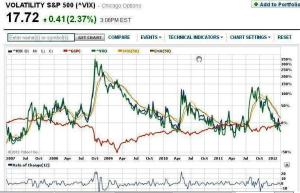Courtesy of Christine Williamson
About three-quarters of executives from a mixed universe of institutional investors think a significant tail-risk event is likely to very likely within the next 12 months, according to a new survey from State Street Global Advisors.
Survey respondents — money managers, family offices, consultants and private banks — expect the five most likely causes of a tail-risk event in the next year would be a global economic recession (36%); a recession in Europe (35%); the breakup of the eurozone (33%); Greece dropping the euro (29%); and a recession in the U.S. (21%). (Percentages total more than 100% because respondents could select multiple causes.)
About 80% said they believe that tail-risk management should be an integral part of portfolio management, and 73% said they are better prepared to weather a severe market downturn since making strategic asset allocation changes after the 2008 market crash.
Fully 80% of the universe said they are somewhat confident to very confident that they have some form of downside protection in place that will protect their portfolio from the ravages of a severe downturn in the market, said Michael Arone, managing director and global head of portfolio strategy at SSgA, in an interview.
When it comes to the strategies that provide the most effective hedge against tail risk, 61% of SSgA’s survey group named diversification over traditional asset classes; 55% cited risk-budgeting techniques; 53%, managed volatility equity allocations; 50%, direct hedges; 43%, other alternative investments; 39%, managed futures allocation; 38%, single-strategy hedge funds; and 37% named hedge funds of funds.
Prior to the 2008 tail-risk event, 89% of institutional investors — a category in which SSgA included pension funds, money managers and private banks — diversified across asset classes, a practice that dropped to 67% in mid-2012. Risk budgeting was employed by 71% of institutional survey respondents pre-crash vs. 63% post-crash in mid-2012; managed volatility equity strategies, 50% pre-crash, 55% mid-2012; managed futures allocation, 44% pre-crash, 39% mid-2012; direct hedging, 36% pre-crash, 44% mid-2012; hedge funds of funds, 41% pre-crash, 28% mid-2012; single strategy hedge funds, 34% pre-crash, 39% mid-2012; and other alternative investments, 57% pre-crash, 58% mid-2012.
SSgA commissioned the survey, which interviewed 310 investment professionals in June and July.
The firm’s full report, “Managing Investments in Volatile Markets,” will be available on Sept. 27.
Original Story Link: http://www.pionline.com/article/20120924/reg/120929951
This copy is for your personal, non-commercial use only. Reproductions and distribution of this news stor

